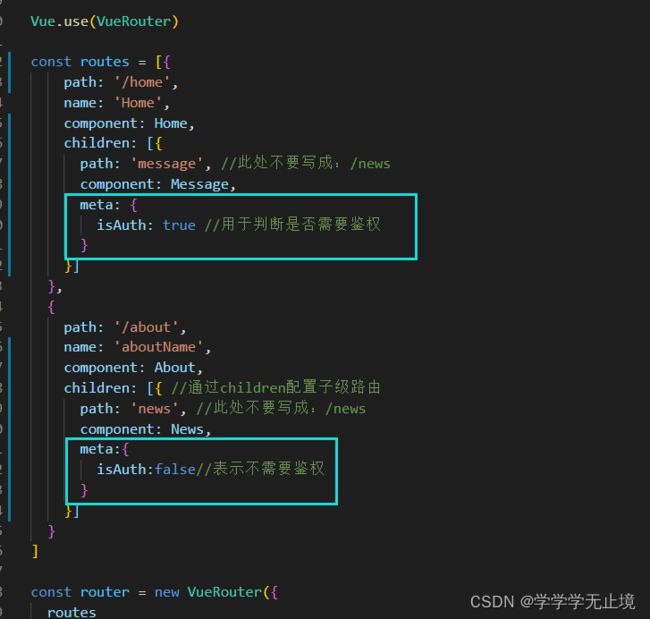Vue中的路由守卫
- 作用:对路由进行权限控制
- 分类:全局守卫、独享守卫、组件内守卫
1.全局守卫
1.1 全局前置守卫
顾名思义,前置守卫主要是在你进行路由跳转之前根据你的状态去 进行一系列操作(全局前置是为在路由初始化以及跳转之前都会触发)
你可以使用router.beforeEach注册一个全局前置守卫(Each:每个,即在任意一个路由跳转的时候都会触发)
每个守卫方法接收三个参数:
- to:Route:即将进入目标的路由对象
- from:Route:当前导航正要离开的路由
- next:function:一定要调用该方法来resolve这个钩子。执行效果依赖next方法的调用参数
1. next():进行管道中的额下一个钩子(to)。如果钩子执行完了,则导航状态就是confirmed(确认的)
2. next(false):中断当前的导航。如果浏览器的URL改变了(可能用户手动或者浏览器按后退按钮),那么地址会重置到from路由对应的地址。
3.next('/")或者next( { path: '/' } ):跳转到一个同的地址。当前的导航被中断,然后进行下一个新的导航。你可以想next传递任意对象,且允许设置诸如replace:true、name:’home‘ 之类的选项以及任何用下router-link的 to prop或者router.push中的选项
确保next函数在任何给定的导航守卫中被严格调用一次,它可以出现多余一次,但是只能在所有的逻辑路径都不重叠的情况下,否则钩子永远都不会被解析或者错误。
1.1.1 使用
- 可以打印出from、to、next看他们究竟会保存那些信息
- 举例
import Vue from 'vue'
import VueRouter from 'vue-router'
import Home from '../views/Home.vue'
import About from '../views/About.vue'
import News from '../views/News.vue'
import Message from '../views/Message.vue'
Vue.use(VueRouter)
const routes = [{
path: '/home',
name: 'Home',
component: Home,
children:[
{
path: 'message', //此处不要写成:/news
component: Message
}
]
},
{
path: '/about',
name: 'aboutName',
component: About,
children: [{ //通过children配置子级路由
path: 'news', //此处不要写成:/news
component: News
}]
}
]
const router = new VueRouter({
routes
})
//全局前置路由守卫---初始化的时候被调用、每次路由切换的时候被调用
router.beforeEach((to, from, next) => {
console.log(to);
//这里是一个简单的例子
//即判断用户是否进入了需要鉴权的路由下(这里距离为news和message)
if (to.path == '/home/message' || to.path === '/about/news') {
//如果进入了,那就判断本地是否缓存了信息(这里模拟登录的token)
if (localStorage.getItem('name') === 'haungzhizhen') {
next()
}
}else{
//如果不是,则直接放心即可
next()
}
})
export default router上面这个例子有个不足之处是,当需要鉴权的路由很多的时候,那你需要一个一个的去判断?那大可不必,因此这里引入路由的另一属性,即meta,可以在每个路由中进行配置,一般用来标识具有标识性的属性,可以用力啊同意判断,具体如下:
//使用meta
router.beforeEach((to, from, next) => {
console.log(to);
if (to.meta.isAuth) {//判断是否需要鉴权
if (localStorage.getItem('name') === 'haungzhizhen') {
next()
}
} else {
next()
}
})1.2 全局后置路由守卫
//全局后置路由守卫---初始化的时候被调用、每次路由切换之后被调用
router.afterEach((to, from) => {
if (to.meta.title) {
document.title = to.meta.title || '路由跳转举例'//修改网页的title
}else{
document.title = 'vue_test'
}
})1.3 整合
2. 路由独享的守卫
你可以在路由配置直接定义beforeEnter守卫,这些参数与全局前置守卫的方法参数是一样的
const router = new VueRouter({
routes: [
{
path: '/foo',
component: Foo,
beforeEnter: (to, from, next) => {
// ...
}
}
]
})3.组件内的守卫
最后,你可以在路由组件内直接定义一下路由导航守卫:
- beforeRouterEnter
- beforeRouterUpdate
- beforeRouterLeave
const Foo = {
template: `...`,
beforeRouteEnter(to, from, next) {
// 在渲染该组件的对应路由被 confirm 前调用
// 不!能!获取组件实例 `this`
// 因为当守卫执行前,组件实例还没被创建
},
beforeRouteUpdate(to, from, next) {
// 在当前路由改变,但是该组件被复用时调用
// 举例来说,对于一个带有动态参数的路径 /foo/:id,在 /foo/1 和 /foo/2 之间跳转的时候,
// 由于会渲染同样的 Foo 组件,因此组件实例会被复用。而这个钩子就会在这个情况下被调用。
// 可以访问组件实例 `this`
},
beforeRouteLeave(to, from, next) {
// 导航离开该组件的对应路由时调用
// 可以访问组件实例 `this`
}
}

